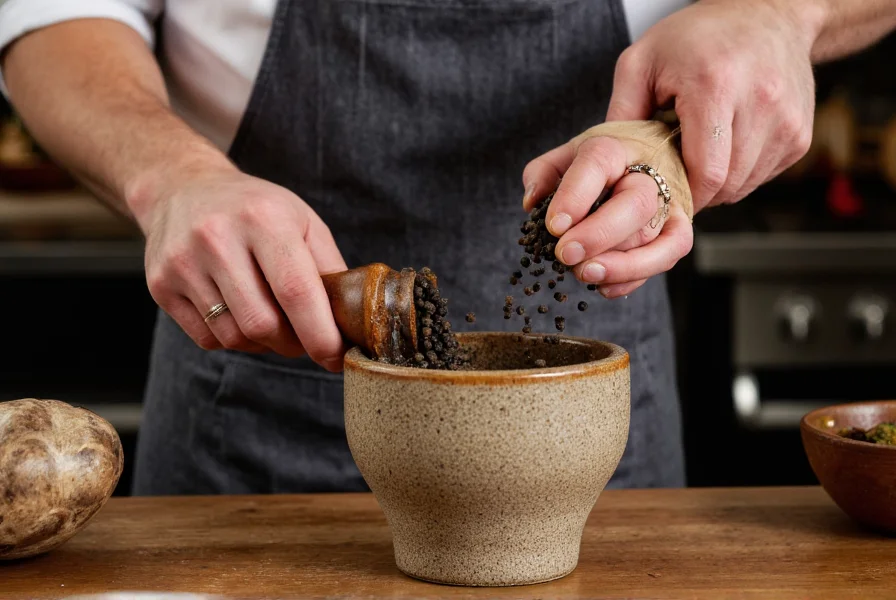Understanding the distinction between peppercorns and pepper is essential for home cooks and culinary professionals alike. Many recipes specify one form over the other, and knowing why can significantly impact your cooking results. This article clarifies the terminology confusion and explains when to use each form for optimal flavor.
What Exactly Are Peppercorns?
Peppercorns are the dried fruit berries of the Piper nigrum vine, a flowering vine in the family Piperaceae. Despite their name, they’re not actual corns or grains but rather small, round berries that grow in clusters. When harvested and dried, these berries become the familiar spice we know as pepper.
The term ‘corn’ in ‘peppercorn’ comes from an old English word meaning ‘small seed or grain,’ not the agricultural crop we associate with corn today. This historical linguistic quirk causes much of the confusion surrounding peppercorns versus pepper.

Types of Peppercorns and Their Processing
Different colors of peppercorns result from varying harvesting and processing methods:
| Type | Harvest Stage | Processing Method | Flavor Profile |
|---|---|---|---|
| Black Peppercorns | Almost ripe | Sun-dried, causing outer layer to ferment and turn black | Strong, pungent, complex with floral notes |
| White Peppercorns | Fully ripe | Soaked to remove outer layer, leaving only seed | Milder, earthier, less complex |
| Green Peppercorns | Unripe | Preserved in brine or freeze-dried | Fresher, fruitier, less pungent |
| Pink Peppercorns | Ripe | Naturally dried (not from Piper nigrum) | Sweet, floral, resinous (technically different plant) |
Peppercorns vs Ground Pepper: Key Differences
The primary difference between peppercorns and ground pepper lies in freshness, flavor intensity, and culinary application. Whole peppercorns retain their essential oils and volatile compounds much longer than pre-ground pepper.
When you grind peppercorns yourself, you release aromatic compounds that begin deteriorating within minutes. Pre-ground pepper found in supermarkets often loses significant flavor during processing and storage. This explains why many chefs insist on freshly grinding peppercorns at the table or during cooking.
When to Use Whole Peppercorns vs Ground Pepper
Certain recipes specifically call for whole peppercorns rather than ground pepper for important culinary reasons:
- Pickling and brining – Whole peppercorns release flavor slowly without making liquids cloudy
- Stocks and soups – Can be easily removed after infusing flavor
- Meat cures – Whole peppercorns provide texture and controlled flavor release
- Whole spice blends – Like bouquet garni where spices are removed later
Conversely, ground pepper works best when immediate flavor distribution is needed, such as in:
- Dry rubs for meats
- Sauces and dressings
- Finishing dishes – Where visible specks of black pepper are desirable
- Baking applications – Where even distribution is critical
Flavor Comparison: Freshness Matters
A side-by-side taste test reveals significant differences between freshly ground pepper and pre-ground versions. Freshly ground pepper from whole peppercorns delivers a complex flavor profile with floral, piney, and citrus notes that pre-ground pepper lacks.
Studies show that ground pepper loses up to 50% of its volatile compounds within 15 minutes of grinding, and continues degrading during storage. This explains why the difference between peppercorns and ground pepper is so pronounced in discerning palates.

Storage Recommendations for Maximum Freshness
To preserve flavor, store peppercorns and ground pepper properly:
- Whole peppercorns – Keep in airtight container away from light and heat; maintains quality for 2-3 years
- Ground pepper – Store in opaque container; best used within 6 months for optimal flavor
For serious cooks, investing in a quality pepper mill and buying peppercorns in small quantities ensures the freshest possible flavor. The culinary uses of peppercorns versus pre-ground pepper become much more apparent when working with fresh, high-quality product.
Common Misconceptions Clarified
Several myths persist about peppercorns versus pepper:
- Myth: “Peppercorns are a different plant than black pepper” Fact: They’re the same plant at different processing stages
- Myth: “White pepper is milder because it’s a different variety” Fact: It’s the same berry with the outer layer removed, changing flavor profile
- Myth: “All black pepper is created equal” Fact: Origin, harvest time, and processing create significant flavor variations
Practical Tips for Home Cooks
Understanding the flavor comparison peppercorns vs ground pepper can transform your cooking:
- Toast whole peppercorns briefly in a dry pan before grinding for enhanced flavor
- Use a coarse grind for steak rubs, fine grind for delicate sauces
- Crush peppercorns with the side of a knife for rustic dishes
- Buy small quantities of whole peppercorns and grind as needed
- Store peppercorns away from strong-smelling spices to prevent flavor transfer











 浙公网安备
33010002000092号
浙公网安备
33010002000092号 浙B2-20120091-4
浙B2-20120091-4